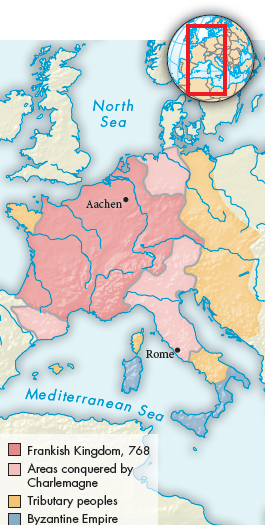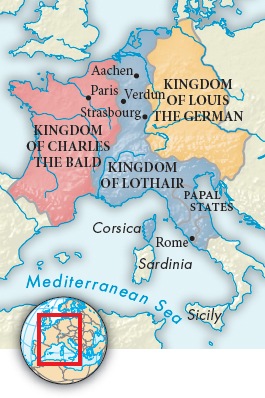Understanding World Societies:
Printed Page 226
The Warrior-Ruler Charlemagne

The most powerful of the Carolingians was Charlemagne. Through brutal military expeditions that brought wealth and by peaceful travel, personal appearances, shrewd marital alliances, and the sheer force of his personality, Charlemagne sought to awe newly conquered peoples and rebellious domestic enemies. By around 805 the Frankish kingdom included all of continental Europe except Spain, Scandinavia, southern Italy, and the Slavic fringes of the East.

For administrative purposes, Charlemagne divided his entire kingdom into counties. Each of the approximately six hundred counties was governed by a count. As a link between local authorities and the central government, Charlemagne appointed officials called missi dominici, “agents of the lord king.” Each year beginning in 802 two missi, usually a count and a bishop or abbot, visited assigned districts. They checked up on the counts and their districts’ judicial, financial, and clerical activities.
In the autumn of the year 800 Charlemagne visited Rome, where on Christmas Day Pope Leo III crowned him emperor. The event had momentous consequences. In taking as his motto Renovatio romani imperi (Revival of the Roman Empire), Charlemagne was deliberately perpetuating old Roman imperial ideas while identifying with the new Rome of the Christian Church. The Byzantines regarded his papal coronation as rebellious and Charlemagne as a usurper. His crowning as emperor thus marked a decisive break between Rome and Constantinople and gave church authorities in the West proof that the imperial title could only be granted by the pope.
As he built an empire through conquest and strategic alliances, Charlemagne also set in motion a cultural revival that later historians called the “Carolingian Renaissance.” The Carolingian Renaissance was a rebirth of interest in, study of, and preservation of the language, ideas, and achievements of classical Greece and Rome. Scholars at Charlemagne’s capital of Aachen copied Greco-
Charlemagne left his vast empire to his sole surviving son, Louis the Pious (r. 814–
The weakening of central power was hastened by invasions and migrations from the north, south, and east. Thus Charlemagne’s empire ended in much the same way that the Roman Empire had earlier, from a combination of internal weakness and external pressure.
>QUICK REVIEW
What role did the Roman Church play in the rise of the Carolingians to power?